09/02/2022
IBA has published it's updated aviation Carbon Emissions Index, ranking the best performing aircraft, airlines and lessors by CO2 emissions.
Our InsightIQ Carbon Emissions Calculator reveals that CO2 emissions in the commercial aviation industry averaged 143.7 grams of CO2 per-seat per-mile in January 2022. This represents a record low in aviation emissions since January 2018.
The marginal drop in these figures compared with recent months is a result of reduced operations from select next-gen aircraft in January 2022, and a slight uptick in utilisation in the largest emissions contributors. Namely, the Boeing 737-800, Airbus A320-200 and Boeing 777-300ER. As the aviation recovery begins to ramp up through 2022 and beyond, IBA expects operators will continue to reactivate their dormant fleets as the requirement for capacity increases. This is likely to result in the global emissions figure creeping up slightly, before plateauing in the next 2-3 years as demand returns and stabilises.
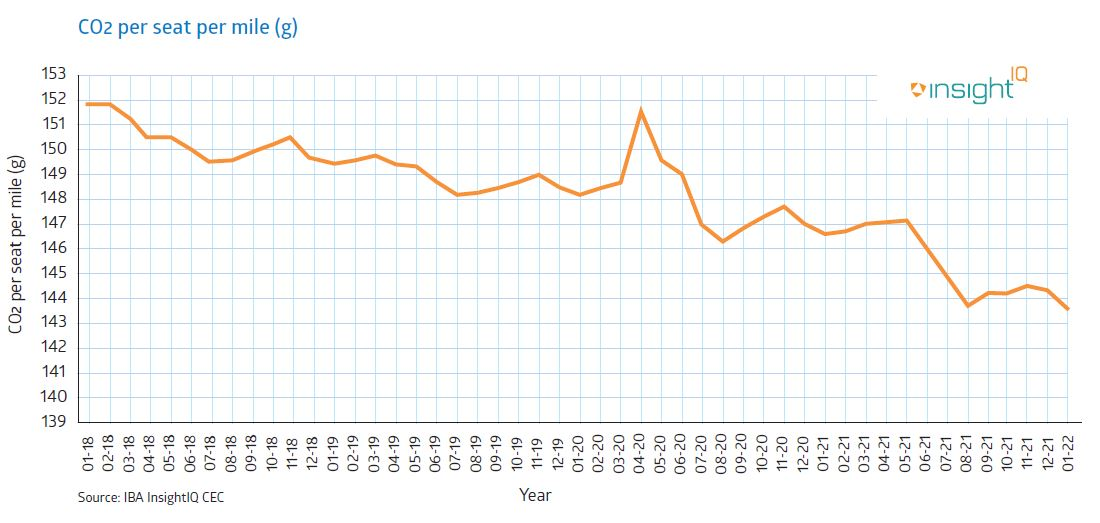
"Our latest Carbon Index showcases the aviation industry's efforts to reduce carbon emissions as we move into a much-needed recovery phase after the pandemic. IBA's Carbon Emissions Calculator is the most advanced and accurate aviation finance emissions monitoring tool on the market, with a unique ability to model scenarios for airline and lessor fleets, and project future emissions. We are committed to using our insights to support the industry as we strive for net-zero by 2050".
Ian Beaumont. Chief Executive Officer, IBA Group.
"We agree that as the aviation recovery begins to ramp up through 2022 and beyond; operators will continue to reactivate their dormant fleets, but focus more on ESG and carbon emissions. This can be seen with the launch of Aircraft Leasing Ireland's ESG narrative, which outlines the tangible steps to be taken by aircraft lessors to support aviation to achieve net-zero carbon emissions by 2050 which we were we're delighted to support".
Kieran O'Brien. Partner, KPMG Ireland.
The global share of emissions remains largely unchanged for January 2022, with the ratios of the highest contributors remaining very similar in comparison to December 2021. However, flight volumes and overall emissions saw a significant drop in comparison, with a total reduction in flight volumes of 7% across the global passenger market from December 2021 to January 2022. The key regions which affected the reduction in passenger traffic were Europe & CIS and North America. Within Europe, domestic travel fell by 13.7% and international traffic fell by 19.2%; largely as a result of new restrictions imposed over the holiday period by many European nations. Similarly, North America experienced a drop in traffic volumes for international travellers of 10% but only a 6% drop in domestic traffic. Since the start of the Covid-19 pandemic, there has been an annual trend around the holiday period due to increased transmission of the virus, new variants, local and international lockdowns and travel restrictions. Most current-generation narrowbody aircraft saw a reduction of between -3% to -7% at the start of 2022, with newer aircraft such as the Boeing 737 MAX 200 and Airbus A321-200NX(LR) seeing a reduction of -15% and 11% respectively.
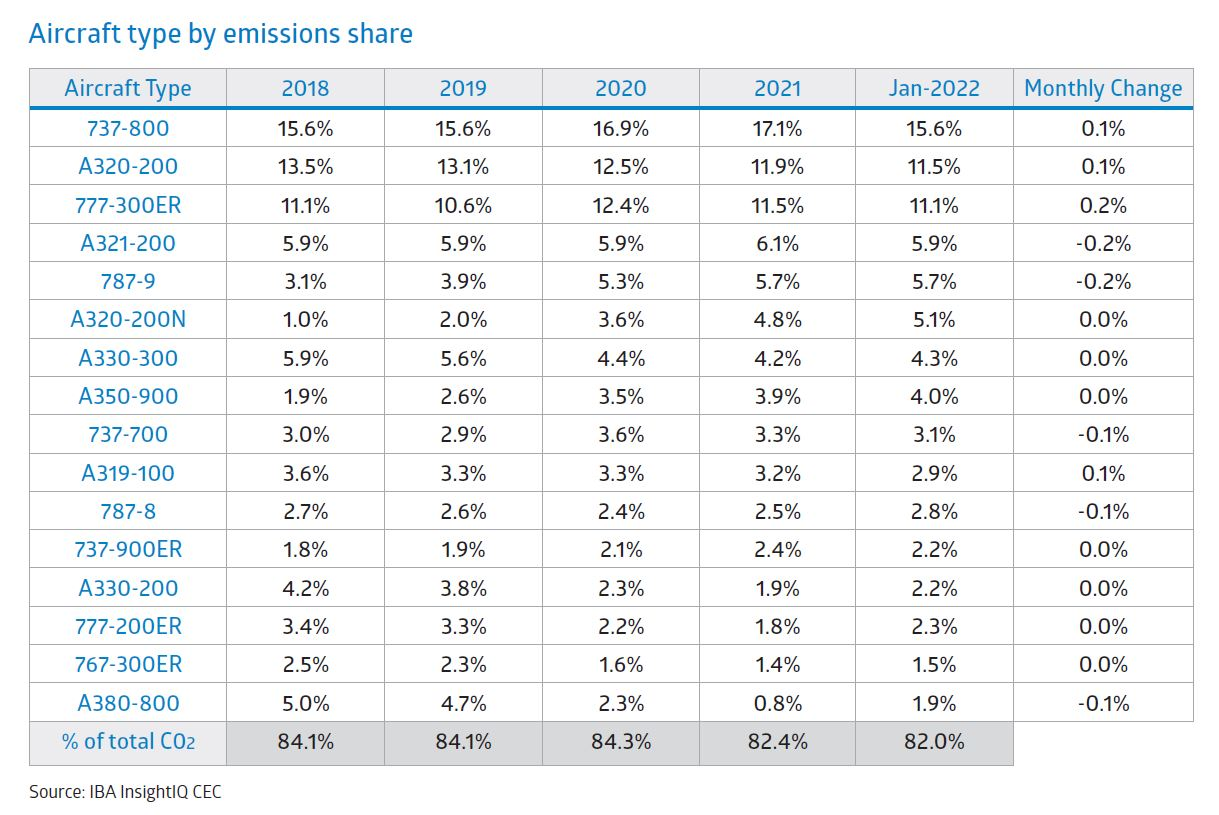
Jackson Square Aviation remains at the top of the lessor efficiency index at the start of 2022, with their portfolio performance having improved by 2 grams per-seat per-mile in January 2022 when compared to December 2021. Although no major fleet exits or changes have happened within the last month, this is largely influenced by the overall utilisation of the assets within the portfolio which has seen a reduction in CO2 intensity across all the top lessors in January.
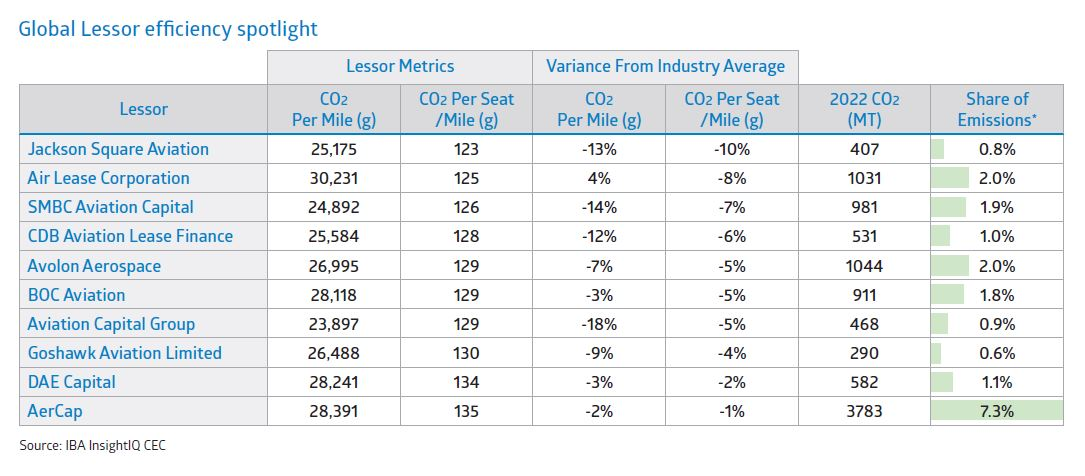
*MT = millions of tonnes of CO2.
January 2022 sees the entry of two low-cost long-haul operators to our airline efficiency ranking. Frenchbee has experienced a rapid increase in flight volumes in December 2021, a trend continuing into 2022. Frenchbee operates four ultra-high-density Airbus A350-900 aircraft and one Airbus A350-1000 (configured in an W40 Y44 00 configuration). This high-density layout in new-generation aircraft contributes significantly towards reducing the overall carbon intensity of Frenchbee's operations. PLAY Airlines has also entered the mix this month, operating routes between Iceland and Europe using the Airbus A321-200neo in an all-economy 192 configuration.
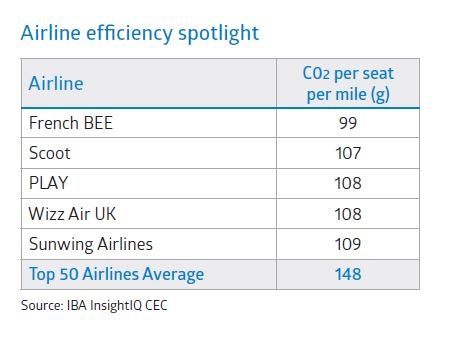
Monthly focus: Fleet renewal drives efficiency for aircraft lessors in the Asia Pacific region
In this month's spotlight feature, IBA has performed an extensive analysis of aircraft leasing companies in the Asia Pacific region (this includes lessors owned by investors in the APAC region but domiciled elsewhere).
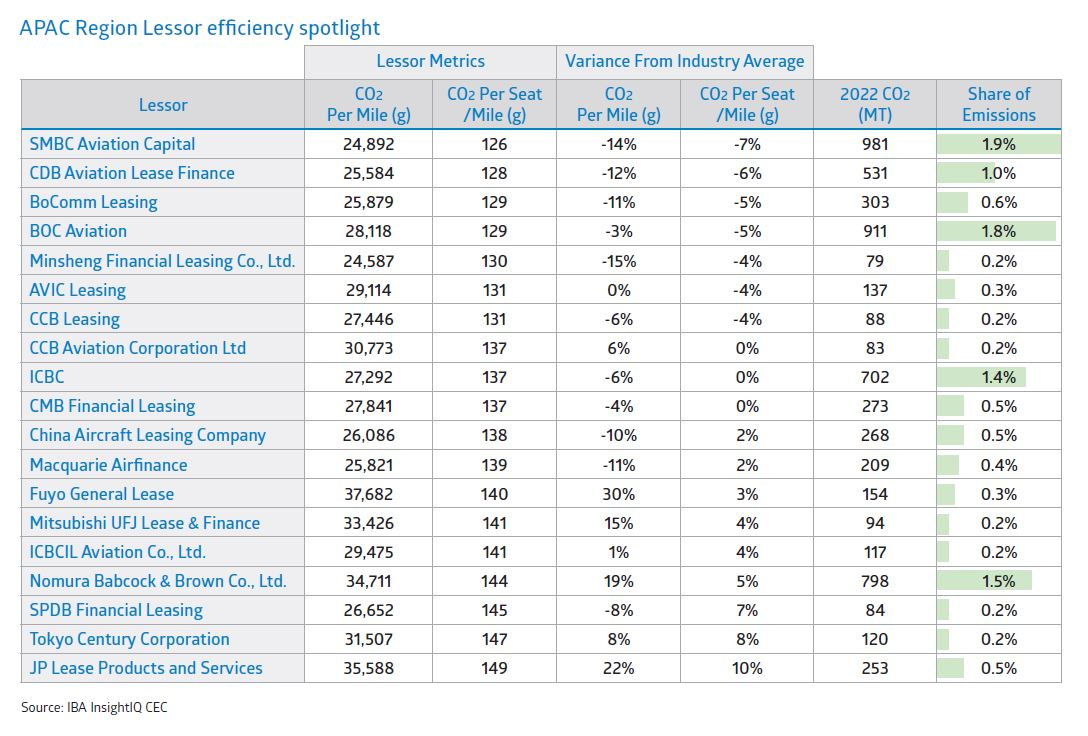
Our aviation carbon emissions analysis has identified SMBC Aviation Capital as the most efficient aircraft lessor in the APAC region, sitting comfortably at the top of our ranking based on intensity and overall fleet size. The lessor has a total of 440 aircraft in service, of the 440 aircraft, 171 of these aircraft are newer generation models. Within the new generation fleet, The average age of their fleet is 8.4 years.
SMBC's overall CO2 share will increase in the coming years due to over 200 new aircraft on order, contributing towards higher overall portfolio emissions. Despite this, we anticipate an overall reduction in CO2 emissions intensity across the whole portfolio as these new generation Airbus A320neo, A321neo and Boeing 737 MAX 8 aircraft are integrated into the fleet.
Singapore based aircraft lessor BOC Aviation is another notable lessor in our ranking. BOC has a similarly sized aircraft portfolio to SMBC, with around 380 aircraft on the books and 105 aircraft orders. Within the BOC aviation fleet, just under 150 aircraft are new generation models. Within the new generation fleet, 78% are narrowbody aircraft and 22% are widebody. BOC Aviation's aircraft orderbook is more diverse than some comparable lessors, with a large blend of new generation Boeing and Airbus Narrowbodies, and Boeing 787 aircraft on order. As with SMBC, we expect BOC's overall carbon intensity to lower as they take delivery of these aircraft, cementing their ranking amongst APAC lessors for the future.
Lower down our ranking, on a CO2 per-seat-per-mile basis, sits SPDB Financial Leasing. A large portion of the SPDB fleet portfolio is focussed on current generation aircraft and regional jets, with regional jets making up 12.5% of the in-service fleet at SPDB.
Regional jets do not typically perform well on a per-seat basis due to lower aircraft cabin density, but do hold a much better performance based on distance (per-mile) when compared to the rest of the market. SPDB Financial Leasing's aircraft orders currently include five Comac C919 aircraft. Whilst there is no publicly available aviation data for fuel burn on the C919; IBA predicts that the aircraft will perform similarly to its Western counterparts due to the selection of the LEAP-1C engine, and will contribute towards lowering SPDB's carbon intensity.
IBA's aviation Carbon Emissions Index is powered by our Carbon Emissions Calculator, part of InsightIQ.
IBA's InsightIQ analysis platform flexibly illustrates multiple asset, fleet and market positions, actual and potential, to inform client choices and identify acquisition opportunities. Immediate access to crucial aircraft, engine, lease rate and fleet data eases appreciation of historic and future aircraft concentrations and operator profiles.
関連コンテンツ